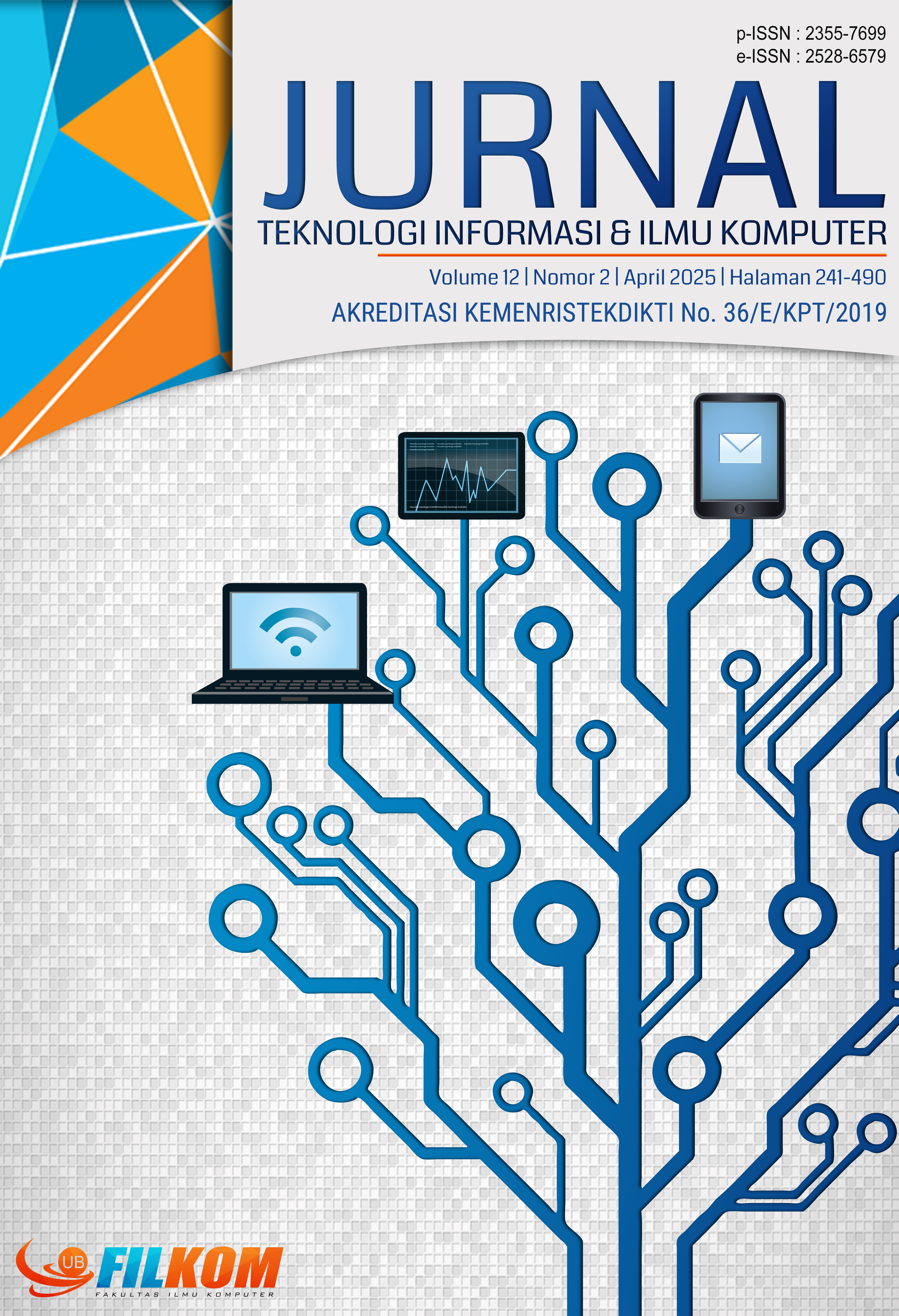Peningkatan Keamanan Pengacakan Soal Ujian Computer Assisted Test (CAT) Penerimaan Mahasiswa UIN Imam Bonjol
DOI:
https://doi.org/10.25126/jtiik.2025129381Kata Kunci:
Computer Based Test (CBT), Kriptografi, Fisher-Yates Shuffle, Chaos MapAbstrak
Teknologi informasi telah membuka akses luas terhadap sumber belajar dan berperan signifikan dalam pelaksanaan tes ujian masuk perguruan tinggi, termasuk adopsi ujian berbasis komputer. Proses penerimaan mahasiswa baru merupakan tugas yang krusial dan menantang. Penelitian ini bertujuan untuk meningkatkan keamanan sistem ujian masuk mahasiswa baru jalur mandiri di UIN Imam Bonjol Padang dengan memperbaiki teknik pengacakan soal pada Computer Assisted Test (CAT). Pengacakan soal dalam sistem CAT yang ada saat ini masih menggunakan prosedur pengacakan standar, yang secara kriptografi tidak aman karena prediktabilitasnya. Untuk mengatasi masalah ini, penelitian mengusulkan penggunaan kombinasi algoritma Fisher-Yates Shuffle dan Chaos Map. Fisher-Yates Shuffle menawarkan efektivitas pengacakan tinggi dengan kompleksitas optimal (O(n)), sementara Chaos Map sangat sensitif terhadap nilai awal, sehingga cocok digunakan untuk pengacakan yang lebih aman. Dengan algoritma ini, soal dan pilihan jawaban diacak berdasarkan nomor peserta, sehingga setiap peserta mendapat soal yang berbeda, mengurangi kemungkinan kecurangan. Hasil penelitian menunjukkan bahwa sistem CAT dengan teknik pengacakan baru ini lebih aman dan efektif dimana terjadi penurunan kemiripan soal sebesar 67,85% dalam tingkat kemiripan soal dari 0,339 menjadi 0,109, yang menunjukkan bahwa algoritma yang diusulkan menghasilkan pengacakan soal yang lebih merata dan lebih sedikit pengulangan soal di antara peserta ujian.
Abstract
Information technology has provided wide access to learning resources and played a significant role in the implementation of college entrance exams, including the adoption of computer-based exams. The process of admitting new students is a crucial and challenging task. This study aims to enhance the security of the independent student entrance exam system at UIN Imam Bonjol Padang by improving the question randomization technique in the Computer-Assisted Test (CAT). The current CAT system still uses a standard randomization procedure, which is cryptographically insecure due to its predictability. To address this issue, the study proposes a combination of the Fisher-Yates Shuffle and Chaos Map algorithms. Fisher-Yates Shuffle offers high randomization effectiveness with optimal complexity (O(n)), while Chaos Map is highly sensitive to initial values, making it ideal for more secure randomization. With this approach, questions and answer choices are randomized based on participant numbers, ensuring each participant receives different questions, thus reducing the possibility of cheating. The results show that the CAT system with this new randomization technique is more secure and effective where there is a 67.85% decrease in the question similarity rate from 0.339 to 0.109, which indicates that the proposed algorithm results in more even question randomization and less question repetition among examinees.
Downloads
Referensi
AGUSTINA, R., RUKHMANA, T., PITRI, N. AND MEIRISA, S., 2023. Sistem Pendidikan Digital. Cendikia Mulia Mandiri.
AKRAM, M., KURNIATI, N. AND SALIM, Y., 2020. Penerapan Algoritma Fisher Yates Shuffle pada Sistem Pembelajaran Tes Online berbasis Aplikasi. Jurnal Telekomunikasi dan Komputer, 10(3), p.145. https://doi.org/10.22441/incomtech.v10i3.8753.
ALAROOD, A.A., ALSOLAMI, E., AL-KHASAWNEH, M.A., ABABNEH, N. AND ELMEDANY, W., 2022a. IES: Hyper-chaotic plain image encryption scheme using improved shuffled confusion-diffusion. Ain Shams Engineering Journal, 13(3), pp.101–583.
ALAROOD, A.A., ALSOLAMI, E., AL-KHASAWNEH, M.A., ABABNEH, N. AND ELMEDANY, W., 2022b. IES: Hyper-chaotic plain image encryption scheme using improved shuffled confusion-diffusion. Ain Shams Engineering Journal, 13(3). https://doi.org/10.1016/j.asej.2021.09.010.
BAHARI, A., 2021. Computer-assisted language proficiency assessment tools and strategies. Open Learning: The Journal of Open, Distance and e-Learning, 36(1), pp.61–87. https://doi.org/10.1080/02680513.2020.1726738.
DUHA, M.W., DEWI, A.R. AND RAHAYU, E., 2022. Online Standard Test System Based on HOTS Using Fisher-Yates Shuffle Algorithm on Final Level Students in Medan State University. CESS (Journal of Computer Engineering, System and Science), 7(2), pp.442–448. https://doi.org/10.24114/cess.v7i2.35657.
FEBRIANI, I., EKAWATI, R., SUPRIADI, U. AND ABDULLAH, M.I., 2021. Fisher-Yates shuffle algorithm for randomization math exam on computer based-test. In: AIP Conference Proceedings. AIP Publishing.
GUPTA, R., GUPTA, P. AND SINGH, J., 2019. Security and Cryptography. In: Software Engineering for Embedded Systems. Elsevier. pp.501–547.
HAZRA, T.K., GHOSH, R., KUMAR, S., DUTTA, S. AND CHAKRABORTY, A.K., 2015. File encryption using fisher-yates shuffle. In: 2015 International Conference and Workshop on Computing and Communication (IEMCON). IEEE. pp.1–7.
LI, C., QIAN, K., HE, S., LI, H. AND FENG, W., 2019a. Dynamics and optimization control of a robust chaotic map. IEEE Access, 7, pp.160072–160081.
LI, C., QIAN, K., HE, S., LI, H. AND FENG, W., 2019b. Dynamics and Optimization Control of a Robust Chaotic Map. IEEE Access, 7, pp.160072–160081. https://doi.org/10.1109/ACCESS.2019.2950457.
MADOURI, Z.B., HADJ SAID, N. AND ALI PACHA, A., 2022. Image encryption algorithm based on digital filters controlled by 2D robust chaotic map. Optik, 264. https://doi.org/10.1016/j.ijleo.2022.169382.
PANDIT, A.A., KUMAR, A. AND MISHRA, A., 2023. Lwr-based quantum-safe pseudo-random number generator. Journal of Information Security and Applications, 73, p.103431.
RISNASARI, M., EFFINDI, M.A., DELLIA, P., CAHYANI, L. AND AINI, N., 2021. Computer Based Test Using the Fisher-Yates Shuffle and Smith Waterman Algorithm. KnE Social Sciences, pp.353–360.
SAHID, A.D., LESTARI, D., SARI, E.R. AND FAUZAN, M., 2019. Sistem Kriptografi Stream Cipher Berbasis Fungsi Chaos Untuk Keamanan Informasi Stream Cipher Cryptography System Based On Chaotic Function For Information Security.
SAOKANI, U., IRFAN, M., MAYLAWATI, D.S., ABIDIN, R.J. AND TAUFIK, I., 2023. Comparison of the Fisher-Yates Shuffle and the Linear Congruent Algorithm for Randomizing Questions in Nahwu Learning Multimedia. Khazanah Journal of Religion and Technology, 1(1), pp.10–14.
SAVITRI, A., 2019. Revolusi industri 4.0: mengubah tantangan menjadi peluang di era disrupsi 4.0. Penerbit Genesis.
SUGIHARTONO, T. AND PUTRA, R.R.C., 2021. Penerapan Algoritma Fisher Yates untuk Pengacakan Soal Pada Sistem Ujian Kompetisi Wartawan. Infotek: Jurnal Informatika dan Teknologi, 4(2), pp.238–248.
SUWARNA, I.P., 2016. Pengembangan instrumen ujian komprehensif mahasiswa melalui computer based test pada program studi pendidikan fisika.
ZANG, X., IQBAL, S., ZHU, Y., LIU, X. AND ZHAO, J., 2016. Applications of chaotic dynamics in robotics. International Journal of Advanced Robotic Systems, 13(2). https://doi.org/10.5772/62796.
Unduhan
Diterbitkan
Terbitan
Bagian
Lisensi
Hak Cipta (c) 2025 Jurnal Teknologi Informasi dan Ilmu Komputer

Artikel ini berlisensiCreative Commons Attribution-ShareAlike 4.0 International License.

Artikel ini berlisensi Creative Common Attribution-ShareAlike 4.0 International (CC BY-SA 4.0)
Penulis yang menerbitkan di jurnal ini menyetujui ketentuan berikut:
- Penulis menyimpan hak cipta dan memberikan jurnal hak penerbitan pertama naskah secara simultan dengan lisensi di bawah Creative Common Attribution-ShareAlike 4.0 International (CC BY-SA 4.0) yang mengizinkan orang lain untuk berbagi pekerjaan dengan sebuah pernyataan kepenulisan pekerjaan dan penerbitan awal di jurnal ini.
- Penulis bisa memasukkan ke dalam penyusunan kontraktual tambahan terpisah untuk distribusi non ekslusif versi kaya terbitan jurnal (contoh: mempostingnya ke repositori institusional atau menerbitkannya dalam sebuah buku), dengan pengakuan penerbitan awalnya di jurnal ini.
- Penulis diizinkan dan didorong untuk mem-posting karya mereka online (contoh: di repositori institusional atau di website mereka) sebelum dan selama proses penyerahan, karena dapat mengarahkan ke pertukaran produktif, seperti halnya sitiran yang lebih awal dan lebih hebat dari karya yang diterbitkan. (Lihat Efek Akses Terbuka).














